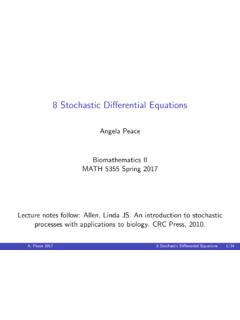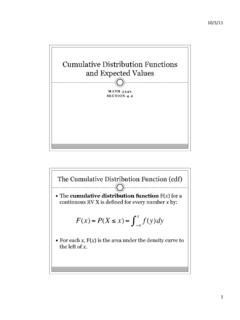Transcription of Practice for Third Exam Math 1352-006, Fall 2003 Dec 1, 2003
1 EXAMP ractice for Third ExamMath 1352-006, Fall 2003 Dec 1, 2003 ANSWERSiProblem 1. In each part determine if the series is convergent or divergent. Ifit is convergent find the sum. (These are geometric or telescopingseries.)A. k= :We have k=352k=523+524+525+ This is a geometric series with ratior= 1/2. Since|r|<1, the series isconvergent. The first term isa= 5/23, so the sum of the series isa1 r=5/81 1/2= 2(58)=54B. k= :We have k=13ek= 3e+ 3e2+ 3e3+ This is a geometric series with ratior=e. Since|r|=e>1, the series k=1( 1)n+ :We have k=1( 1)n+1272k=272 274+276 278+ This is a geometric series with ratior= 1/72= 1/49. Since|r|= 1/49<1, the series is convergent.
2 The first term isa= 2/72, so the sum isa1 r=2/491 ( 1/49)=2/491 + 1/49=2/4950/49=4950249=250= 1/251D. k=31k(k+ 1).Answer:Partial fractions gives1k(k+ 1)=1k 1k+ 1(check). Thus, we can write k=31k(k+ 1)= k=3[1k 1k+ 1].Noting that the sum starts atk= 3, we have the following for the 14S2=13 14+14 15=13 15S3=13 14+14 15+15 16=13 1n+ 3 Sincelimn Sn=13 0 = 1/3,we conclude that the series converges and that the sum is 1 2. In each part, express the given number as a single :We = = + + + + =710+7102+7103+7104+ 2 This is a geometric series with ratior= 1/10 (so it s convergent) and firstterma= 7/10. Thus, we =a1 r=7/101 1/10=710910=109710= :We can write(1) = + the repeating decimal, we = + + + =21104+21106+21108+ This is a geometric series with ratior= 1/102= 1/100 (|r|<1, so it sconvergent) and first term 21/104.
3 Thus, we =a1 r=211041 1100=2110499100=1009921104=2199(100)=733 (100)= course, we also =2354100,and so, by (1), we =2354100+73300= rubber ball is dropped from a height of 12 feet. After each bounce, theball goes up to 3/4 of the distance it previously fell. What is the total verticaldistance traveled by the ball?Answer:The ball falls 12 feet to the floor. On the first bounce it goes up to a heightof (3/4)(12). Thus, on this bounce, the ball travels (3/4)(12) up and travels(3/4)(12) down, for a total distance of 2(3/4)(12). On the second bounce itgoes up to a height of (3/4)[(3/4)(12)] = (3/4)2(12). Thus, it travels (3/4)2(12)up and (3/4)2(12) down for a total distance of 2(3/4)2(12) on the second distance traveled on the Third bounce is 2(3/4)3(12) and so , the total distance traveled is(2)D= 12 + 2(3/4)(12) + 2(3/4)2(12) + 2(3/4)3(12) + The series2(3/4)(12)+2(3/4)2(12)+2(3/4)3(12) + = 24(3/4)+24(3/4)2+24(3/4)3+ is a geometric series withr= 3/4 (and so it s convergent) and first terma=24(3/4) = 18.
4 Thus, the sum of the series isa1 r=181 3/4=181/4= 4(18)= , from (2), we haveD= 12 + 72 = 4. In each part, determine if the series is convergent or sure to say which test you are using and to show the detailsof how the test is k=1e :We have k=1e 3k=e 3+e 6+e 9+ This is a geometric series withr=e 3. Since|r|<1, the series isconvergent. The sum isa1 r=e 31 e k=11k2 :This is ap-series withp= 2/3. By thep-Series Test (p. 519) the seriesis divergent, sincep= 2/3 (3) k=1k2k8+k5+ :Keeping just the fastest growing terms on the top and bottom, we havek2k8+k5+ 7 k2k8= series(4) k=11k6is ap-series withp= 6>1, so is convergent.
5 We use the Limit Com-parison Test (p. 523) to compare the series k=1ak= k=1k2k8+k5+ 7and k=1bk= k= haveakbk=k2k8+k5+ 71k6=k8k8+k5+ 7=11 + 1/k3+ 7/k8 1 = 0<L< , the Limit Comparison Test says that both series con-verge or both diverge. Since we know that the series (4) is convergent,we conclude that the series (3) is k=21kln(k).Answer:We apply the Integral Test (p. 516) withf(x) = 1/(xln(x)). Forx 2,this function is positive. It is clear enough thatfis decreasing on [2, )since bothxand ln(x) are increasing functions. Thus, we can apply theintegral test. We need to check the integral 21xln(x)dx= 21ln(x) the substitutionu= ln(x).]
6 Then we havedu=dx/x, so we have 21ln(x)1xdx= ln(2) we have changed the limits is accordance withu= ln(x). Wehave ln(2)1udu= ln(u) u= u=ln(2)= [ limu ln(u)] ln(ln(2))= .So this integral diverges. The Integral Test tells us that the series andthe integral and the series both converge or both diverge. We concludethat the series is k=1k22k2+ :We havelimk k22k2+ 1= limk 12 + 1/k2=12 Since thek-th term of the series does not approach 0 ask , theDivergence Test (p. 515) says that our series is k= :Apply the Ratio Test (p. 527). Thek-th termakis given byak=k32kand so we haveak+1=(k+ 1)32k+1 Then we haveak+1ak=(k+ 1)32k+1k32k=2kk3(k+ 1)32k+1=12(k+ 1k)3=12(1 + 1/k)3 12(1 + 0)3=12= <1, the Ratio Test tells us the series is k=1(k2k+ 1) :Apply the Root Test (p.)
7 530). In the notation of the Root Test, wehaveak=(k2k+ 1) we havek ak=[(k2k+ 1)k]1/k=k2k+ 1=12 + 1/k 12 + 0= 1/2 = 1/2<r, the Root Test tells us the series is (5) k=11 2k+ :Keeping only the fastest growing term on the bottom, have1 2k+k 1 2k=1[ 2] series(6) k=11[ 2]kis a geometric series with ratior= 1/ 2. Since|r|<1, we concludethat (6) is , we apply the Limit Comparison Test with k=1ak= k=11 2k+ k=1bk= k=11[ 2] haveakbk=1 2k+k1 2k= 2k 2k+k= 2k2k+k= 11 +k/2k 11 + 0= 1 =L,where we ve usedk/2k 0 ask . Since 0<L< , the LimitComparison Test tells us that either both series converge or both di-verge. Since we know (6) is convergent, we conclude that (5) is k=12kk!
8 Answer:Use the Ratio Test. We haveak=2kk!and soak+1=2k+1(k+ 1)!9 Thus, we can computeak+1ak=2k+1(k+ 1)!2kk!=k!2k2k+1(k+ 1)!= 2k!(k+ 1)!= 21 2 3 k1 2 3 k (k+ 1)=2k+ 1 0 = 0<1, the Ratio Test tells us the series is k=1e 5 :Sincelimk 5k= 0,we havelimk e 5/k=e0= thek-th term of the series does not go to zero ask , theDivergence Test tells us the series is k=132k+1(2k+ 1)!.Answer:Apply the Ratio Test. We haveak=32k+1(2k+ 1)!and soak+1=32(k+1)+1(2(k+ 1) + 1)!=32k+3(2k+ 3)!.10 Thus, we can computeak+1ak=32k+3(2k+ 3)!32k+1(2k+ 1)!=(2k+ 1)!32k+132k+3(2k+ 3)!= 32(2k+ 1)!(2k+ 3)!= 91 2 3 (2k+ 1)1 2 3 (2k+ 1)(2k+ 2)(2k+ 3)=9(2k+ 2)(2k+ 3) 0 = 0<1, the Ratio Test tells us the series is k=21[ln(k)] :Use the Root Test.
9 We computek ak=[1[ln(k)]k]1/k=1ln(k) 0 = 0<1, the Root Test tells us the series is (7) k=1k2 k5+k3+ :Keeping only the fastest growing terms on top and bottom, we havek2 k5+k3+ 2 k2 k5=k2k5/2=1k5/2 4/2=1k1 series(8) k=11k1/2is ap-series withp= 1/2 1, and so is apply the Limit Comparison Test with k=1ak= k=1k2 k5+k3+ 2and k=1bn= k=11 computeakbk=k2 k5+k3+ 21 k= kk2 k5+k3+ 2= k k4 k5+k3+ 2= k5k5+k3+ 2= 11 + 1/k2+ 2/k5 11 + 0 + 0= 1 = 0<L< , the Limit Comparison Test tells us both seriesconverge or both series diverge. Since we know that (8) diverges, weconclude that (7) k= :Use the Ratio Test. We haveak=2kk1012and soak+1=2k+1(k+ 1) computeak+1ak=2k+1(k+ 1)102kk10=k102k2k+1(k+ 1)10= 2(kk+ 1)10= 2(11 + 1/k)10 2(11 + 0)10= 2 = 2>1, the Ratio Test tells us the series (9) k=21ln(k).
10 Answer:Use the Zero-infinity Limit Comparison Test (p. 525) with k=2ak= k=21ln(k)and k=2bk= k= course, we know that(10) k=2bk= k=11k13is divergent. We computeakbk=1ln(k)1k=kln(k) The second part of the Zero-infinity Limit Comparison Test tells us that akis divergent if bkis divergent. Since we know (10) is divergent,we conclude (9) is 5. Assume thatx>0. In each case, find the set of allx>0 forwhich the series k=1xkk!Answer:Use the ratio test, withak=xk/k!. Then,ak+1ak=xk+1(k+ 1)!xkk!=k!xkxk+1(k+ 1)!=xk!(k+ 1)!=x1 2 3 k1 2 3 k (k+ 1)=xk+ 1 0 = the ratio test is 0<1 for allx, there series converges for allx> (11) k=1xkk2kAnswer:Try the ratio test, withak= we haveak+1ak=xk+1(k+ 1)2k+1xkk2k=k2kxkxk+1(k+ 1)2k+1=xk+1xk2k2k+1kk+ 1=x(2)11 + 1/k x/2 = series converges ifr<1, , ifx/2<1 orx<2.




